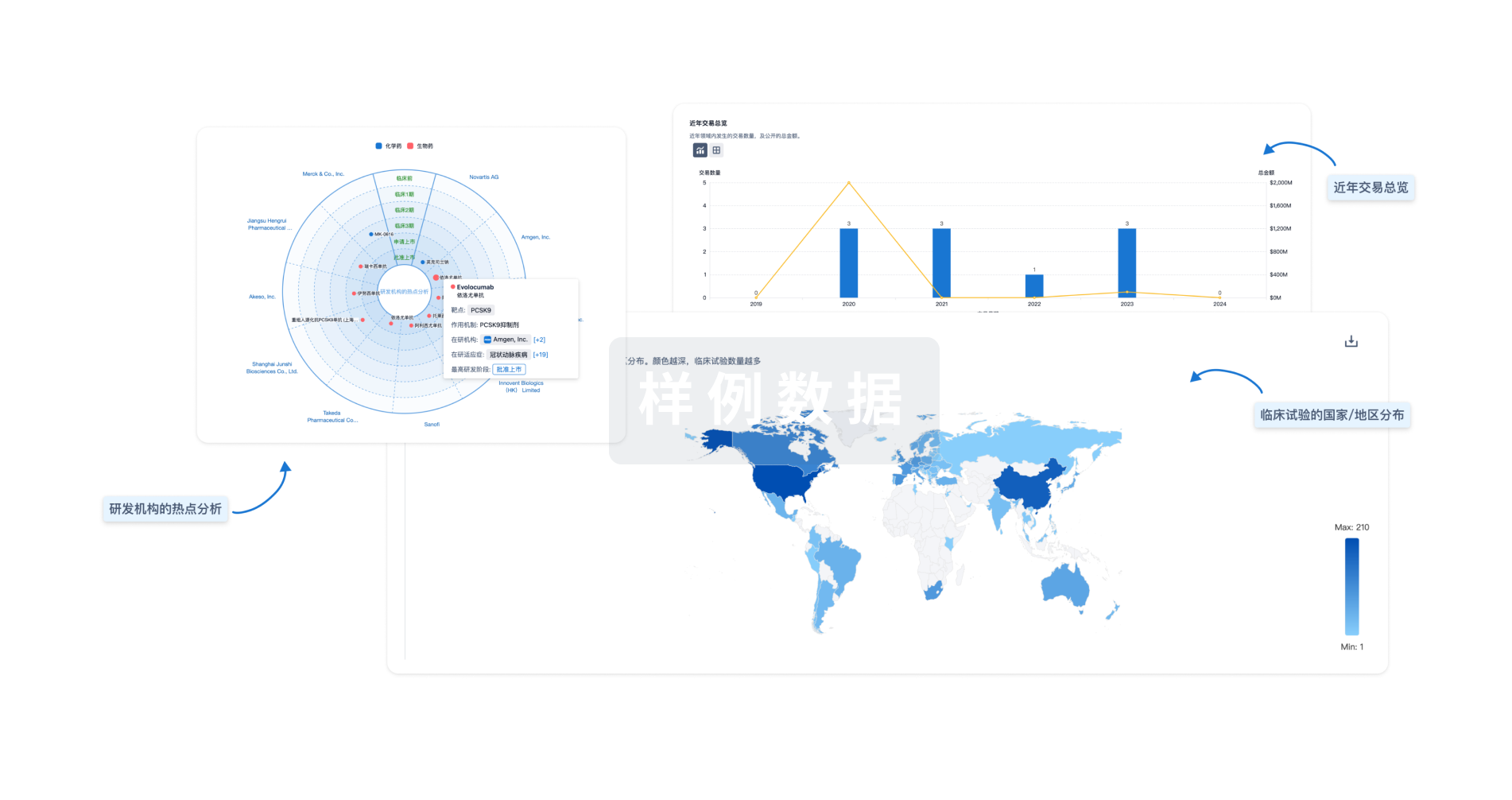预约演示
更新于:2025-05-07
XRCC1
更新于:2025-05-07
基本信息
别名 DNA repair protein XRCC1、RCC、X-ray repair cross complementing 1 + [2] |
简介 Scaffold protein involved in DNA single-strand break repair by mediating the assembly of DNA break repair protein complexes (PubMed:11163244, PubMed:28002403). Negatively regulates ADP-ribosyltransferase activity of PARP1 during base-excision repair in order to prevent excessive PARP1 activity (PubMed:28002403, PubMed:34102106, PubMed:34811483). Recognizes and binds poly-ADP-ribose chains: specifically binds auto-poly-ADP-ribosylated PARP1, limiting its activity (PubMed:14500814, PubMed:34102106, PubMed:34811483). |
关联
100 项与 XRCC1 相关的临床结果
登录后查看更多信息
100 项与 XRCC1 相关的转化医学
登录后查看更多信息
0 项与 XRCC1 相关的专利(医药)
登录后查看更多信息
2,818
项与 XRCC1 相关的文献(医药)2025-12-01·Molecular Biology Reports
Association of XRCC1 (rs1799782) and XPD (rs13181) gene polymorphisms with renal failure risk in a sample of Iraqi population: a case–control study
Article
作者: Al-Koofee, Dhafer A F ; Abo-Ghneim, Fahad D F ; Mohammed, Hussain Jasem
2025-10-01·Computational Biology and Chemistry
The drug discovery candidate for targeting PARP1 with Onosma. Dichroantha compounds in triple-negative breast cancer: A virtual screening and molecular dynamic simulation
Article
作者: Kareem, Radhwan Abdul ; Taher, Waam Mohammed ; Jawad, Mahmood Jasem ; Saadh, Mohamed J ; Mishra, Anurag ; Verma, Lokesh ; Ahmed, Hanan Hassan ; Hamad, Atheer Khdyair ; Prasad, G V Siva ; Alwan, Mariem ; Chandra, Muktesh
2025-06-01·IJC Heart & Vasculature
Reappraisal of the clinical and anatomic characteristics of idiopathic outflow tract ventricular arrhythmias with an R wave pattern break in precordial lead: A multi-center study
Article
作者: Chang, Ting-Yung ; Li, Guan-Yi ; Amadis, Muhammad Rafdi ; Higa, Satoshi ; Lin, Yenn-Jiang ; Bautista, Jose Antonio Lopez ; Chung, Fa-Po ; Liu, Shin-Huei ; Phang, Yuen Hoong ; Kuo, Ming-Jen ; Chang, Shih-Lin ; Nguyen-Khac, Thien-Chuong ; Kuo, Ling ; Hu, Yu-Feng ; Liu, Chih-Min ; Lo, Li-Wei ; Chiang, Chia-Hsin ; Wu, Cheng-I ; Huang, Yu-Shan ; Chen, Shih-Ann ; Lin, Chin-Yu
17
项与 XRCC1 相关的新闻(医药)2025-03-01
·药时空
个性化癌症疫苗(PCVs)在癌症免疫治疗中极具潜力,旨在引导免疫系统对抗肿瘤特异性新抗原。然而,其在靶向癌症驱动突变、诱导肿瘤识别以及实现临床获益方面的效果,尤其是在低突变负荷肿瘤中的作用,仍不明确。
2月5日,丹娜法伯癌症研究所Toni K. Choueiri、Catherine J. Wu,耶鲁大学David A. Braun共同通讯在《Nature》发表论文“A neoantigen vaccine generates antitumour immunity in renal cell carcinoma”,报道了一项临床I期试验,聚焦于高危、完全切除的透明细胞肾细胞癌(RCC),一种突变负荷相对较低但具有明确驱动突变的肿瘤类型,以探究靶向新抗原的PCVs的作用。
同时,《Nature》CLINICAL BRIEFINGS栏目对此论文进行了报道“A personalized cancer vaccine to prevent the return of high-risk kidney cancer”。
在这项研究中,招募了9名高危RCC(III期或IV期)患者。患者的基线特征符合高危RCC的典型特征,大多数患者在入组时患有高级别疾病或转移性疾病。为每位患者成功制备并接种了PCV。该疫苗包含多种含有新抗原的肽,每位患者的肽中位数为15种,部分肽来源于移码插入、缺失或癌症驱动突变。
临床结果令人瞩目。术后中位随访40.2个月,从PCV开始接种起中位随访34.7个月,9名患者均未出现RCC复发。1名患者因与RCC或治疗无关的精神健康相关并发症死亡。这种无复发的情况表明,PCV可能对预防高危RCC患者的疾病复发有效,尽管样本量较小,还需进一步确认。
PCV的安全性良好。最常见的不良事件是低级别的注射部位反应和短暂的流感样症状,且没有患者出现3级或更高级别的(剂量限制性)毒性。这与辅助免疫检查点抑制形成对比,后者更易出现更高级别的毒性,凸显了PCV作为低毒性治疗选择的潜力。
从免疫学角度来看,PCV在所有患者中均具有高度免疫原性。所有患者都产生了针对PCV抗原的T细胞免疫反应。9名患者中有5名对所有4个肽库产生了疫苗特异性免疫反应。不同患者的峰值免疫反应出现时间各异,但9名患者中有6名在接种疫苗后24周观察到最高的体外T细胞反应。体外刺激后,患者对中位数为7种新抗原疫苗肽表现出免疫反应。
重要的是,该疫苗能够靶向关键的RCC驱动突变。6名患者接种了包含常见RCC驱动突变的肽,其中7种肽中有6种诱导了免疫反应。在所有泛癌驱动突变中,65%具有免疫原性。接种疫苗还导致循环血浆蛋白发生广泛且持久的变化,包括支持T细胞分化和效应功能的细胞因子增加,以及T细胞活化和细胞毒性标记物增多 。尽管一些血管生成和免疫抑制标记物也有所增加,但这仍表明免疫反应发生了广泛重塑。
接种疫苗增加了皮肤浸润的细胞毒性T淋巴细胞。皮肤中的抗原呈递细胞相对减少,这可能是由于它们迁移到了引流淋巴结。在皮肤浸润的T细胞中,独特T细胞克隆型的数量增加,细胞毒性T细胞和增殖性自然杀伤细胞群体的相对比例呈上升趋势。这些群体中效应细胞因子和细胞毒性基因的表达也有所增加。
此外,PCV诱导了持久的抗肿瘤免疫。接种疫苗后,疫苗特异性T细胞克隆迅速且持久地扩增。这些扩增的克隆主要是CD4 T细胞,并且疫苗扩增的CD4克隆型数量与IFNγ反应相关。针对含有RCC驱动突变的疫苗肽扩增的外周T细胞能够直接识别自体肿瘤细胞,77.8%的患者检测到抗肿瘤反应。
总之,这项I期试验提供了令人鼓舞的证据,表明高危RCC中靶向新抗原的PCV具有高度免疫原性,能够靶向关键驱动突变并诱导抗肿瘤免疫。所有接种疫苗的患者均未出现疾病复发,且安全性良好,这表明PCV有望成为RCC的辅助治疗手段。然而,还需要更大规模的研究来证实这些发现,并充分了解这种方法的临床疗效。
https://doi.org/10.1038/s41586-024-08507-5
识别微信二维码,可添加药时空小编
请注明:姓名+研究方向!
疫苗临床3期
2025-02-27
·今日头条
疫苗无疑是本世纪人类最伟大的发明之一!暨成功终结肆虐的天花、脊椎灰质炎以及新冠病毒等致命疾病后,癌症疫苗终于研发成功,有望在注射后
唤醒我们的免疫系统重新试别和杀伤癌细胞,同时产生免疫记忆反应,让免疫系统能够建立起阻断癌症的“金钟罩”,在未来十年甚至一生中持续保护我们
,每当体内出现癌细胞的时候,免疫系统都能自动发起攻击,使其在形成肿瘤之前就杀死它们,保护我们远离复发!
“医生,我的肿瘤切干净了吗?还会不会复发?”这是每一位术后患者最揪心的提问。全球每年约1000万癌症患者术后复发,即使接受手术联合免疫治疗,仍有超50%在5年内复发,生存率断崖式下跌!更残酷的是,复发后治疗手段有限,患者往往陷入“化疗—耐药—进展”的死亡循环。
2025年,全球癌症疫苗研发遍地开花,并取得了令人振奋的临床数据,已经掀起了新⼀波肿瘤免疫治疗浪潮!
一、死亡风险降低62%!全球首款mRNA癌症疫苗--mRNA上市在即
mRNA-4157(V940)
属于一种mRNA个体化新抗原疗法,由编码多达34种新抗原的合成mRNA组成,旨在根据患者肿瘤DNA序列的独特突变特征,产生特定的T细胞反应,来训练和激活抗肿瘤免疫反应,从而达到抗癌目的。目前,这款疫苗被美国食品药品监督管理局(FDA)授予“突破性治疗指定”,并被欧洲药品管理局授予“优先药物(PRIME)计划”,有望成为
全球首款上市的mRNA肿瘤疫苗
!癌症复发及死亡风险降低49%!新型癌症疫苗启动Ⅲ期临床实验
2024年公布的最新的结果显示,与单独使用PD-1相比,癌症疫苗mRNA-4157 (V940) 与PD-1( KEYTRUDA) 联合使用可将致命癌症复发或死亡风险降低
49%
,远处转移或死亡风险降低
62%
!
这款疫苗最早可能会获得监管部门的批准,并最早于
2025
年在一些国家推出。”这意味着,用疫苗治疗癌症的梦想即将照进现实!
二、mRNA疫苗持续有效长达7.7年!胰腺癌生存期可延长至6年!
2月19日,国际重磅期刊《Nature》上刊登了一款可用于实体肿瘤的mRNA 新抗原疫苗最新研究成果,引起巨大轰动!在应答者中,自基因 cevumeran 诱导的 CD8 + T 细胞克隆平均估计寿命为
7.7
年(范围为
1.5 至约 100 年
),其中约 20% 的克隆具有数十年的潜伏寿命,可能比宿主存活时间更长,这意味着这款新型的癌症疫苗可以帮助延缓或防止癌症复发!
Autogene cevumeran是一种针对每位肿瘤患者量身定制的个体化肿瘤疫苗。它是基于美国BioNTech公司强大的技术平台生成的个体化新抗原疫苗,可以编码数十种新抗原,可以激发人体针对肿瘤细胞产生全面的免疫反应,防止肿瘤细胞逃避免疫系统的攻击。
2023年5月10日初次公布了1.5 年中位随访数据,并发表在国际重磅期刊
《Nature》
上引起巨大轰动。2024年AACR大会上更新的3年随访数据继续显示,胰腺癌患者在手术后注射个体化 mRNA 癌症疫苗
Autogene cevumeran(代号为 BNT122、RO7198457)
进行辅助治疗,可延迟胰腺癌复发,研究还表明,在单次疫苗加强接种后,中位寿命可延长至 6 年!
一位幸运的胰腺癌患者在接受疫苗治疗后已经5年无癌并且不需要化疗,2024年底,她迎来了自己的第8个孙子,她激动地说“到目前为止我感觉很好,目前还没有发现癌症,我非常感激能够接受它。机会和时机是如此完美。它让我的生活焕然一新,我希望它也能帮助别人。
三、100%患者3年未复发!个体化癌症疫苗有望将“绝症”变为“慢性病”
近期,国际重磅期刊《Nature》上发表的一篇文章引起巨大轰动,各大媒体争相报道这一爆炸性新闻:100%患者在术后注射癌症疫苗后长达3年未复发,最长无癌生存达到4年!个体化新抗原疫苗(PCV)取得震撼突破,有望打破癌症“死亡魔咒”,开启将“绝症”转为“慢性病”的新纪元!100%患者3年未复发!个体化癌症疫苗有望将“绝症”变为“慢性病”
2025年2月,《自然》杂志发布全球知名的癌症中心丹娜-法伯癌症研究所与耶鲁大学的重磅研究成果,引起巨大轰动:9名高风险肾癌患者术后接受个体化新抗原疫苗(PCV),中位随访40.2个月,100%未复发,最长无癌生存达近4年!这一成果为癌症治疗注入强心剂!
在这项由研究人员发起的试验中, 9 名 III 期或 IV 期透明细胞肾细胞癌患者在手术后进行了个性化癌症疫苗治疗。其中 5 名患者还接受了伊匹单抗治疗。
“
个性化癌症疫苗(PCV)像一张‘癌细胞通缉令’,教会免疫系统锁定目标。这是实体瘤治疗里程碑!
”
这款癌症疫苗是个性化的,通过手术中切除的肿瘤组织作为指导来识别患者的癌症。研究人员从肿瘤细胞中提取出与正常细胞不同的分子特征。这些特征被称为新抗原,是存在于癌症中但不存在于身体其他细胞中的突变蛋白的微小片段。 该团队使用预测算法,根据这些新抗原诱发免疫反应的可能性来确定疫苗中应包含哪些新抗原。然后,疫苗被制造出来,患者接受不同初始剂量和随后的两次加强剂量注射。
个体化新抗原疫苗(PCV)三大核心优势:
精准打击:基于患者肿瘤特异性突变生成新抗原,免疫系统“定向清除”癌细胞,避免误伤正常组织。
长效免疫记忆:疫苗激发的T细胞扩增166倍,持续活跃3年以上,形成“抗癌哨兵”。
安全可控:仅出现注射部位红肿、流感样症状,无3级以上毒性,耐受性极佳。
结果显示:
在手术后中位随访 40.2 个月时,参与研究的 9 名参与者中无一出现 RCC 复发。
未观察到剂量限制性毒性。
所有患者均产生了针对 PCV 抗原的 T 细胞免疫反应,包括针对VHL、PBRM1、BAP1、KDM5C和PIK3CA中的RCC 驱动突变。
接种疫苗后,外周 T 细胞克隆出现持久扩增。
在9名患者中,有7名检测到针对自体肿瘤的 T 细胞反应性。
Kaplan-Meier生存曲线图(1 名患者死于与 RCC 或治疗无关精神健康相关并发症。)
令研究人员振奋的是,疫苗在短短三周内就能诱发免疫反应,疫苗诱导的T细胞数量平均增加了
166倍
,并且这些T细胞在体内保持高水平长达3年之久。体外研究还表明,疫苗诱导的T细胞对患者自身的肿瘤细胞具有活性。这意味着,疫苗在唤醒免疫系统的同时还产生了免疫记忆,让免疫系统可以持续消灭癌细胞,长期保护我们。
四、生存期长达4年以上!国研癌症疫苗取得突破性研究成果
近日,中国自主研发的肿瘤新生抗原mRNA疫苗产品——LK101注射液成功获得美国食品药品监督管理局(FDA)的IND(临床试验申请)批准。这是中国首个在FDA获批的肿瘤新生抗原mRNA疫苗产品,标志着中国在肿瘤免疫治疗领域的创新实力得到了国际认可,也为全球癌症患者带来了新的希望。
新型个体化癌症疫苗
LK101
是一种个性化的新抗原靶向癌症疫苗,也是一种基于树突状细胞 (DC) 的 mRNA 疫苗,它采用专利技术结合了 mRNA 和 DC 的优势,根据数10种患者特异性肿瘤突变信息将编码个性化肿瘤抗原靶点的 mRNA 转导到树突状细胞中,从而激活针对癌细胞的特异性免疫反应,被“唤醒”的免疫系统可以发起攻击清除体内肿瘤。
首次人体试验(临床试验信息:NCT03674073)的惊艳数据,初步证实了这款个性化的基于新抗原的 mRNA 负载树突状细胞(DC)疫苗与消融术相结合显著降低了肝细胞癌患者的复发率。疫苗接种组和对照组患者的中位随访时间为
48.4个月和38.8个月
。消融对照组有3名患者死亡,而所有接种疫苗的患者均存活。这意味着,
12名接受疫苗的患者生存期长达4年以上
!
五、64%胰腺癌实现2年无复发!树突细胞治疗打破“癌王”死亡魔咒
近期,荷兰鹿特丹伊拉斯姆斯癌症研究所外科专家们对接受标准护理 (SOC) 治疗后手术切除的胰腺癌患者进行了基于树突细胞(DC)的免疫疗法的 I 期试验,评估树突细胞疗法在胰腺癌治疗中的效果,初步结果非常振奋人心!结果显示:经过中位
25.5 个月
的随访,26 名患者(68%)没有出现疾病复发,估计的 2 年 无复发生存率(RFS) 达到了
64%
。而在其他未接受该疗法的队列中,2 年 RFS 仅在 20%-25% 左右。
目前癌症疫苗术是癌症免疫治疗领域最热门的研究方向之一,全球有数百个研究小组在组织攻关,当癌症从“绝症”变为“慢性病”,疫苗正成为改写命运的关键拼图。好消息是国内患者现在可通过全球肿瘤医生网医学部向中国、日本或古巴医疗机构申请相关疫苗,配合标准治疗延长生存期,提高生活质量!打一针治疗肿瘤的时代即将到来!或许下一次突破,就能让“无癌余生”成为常态。
本文为全球肿瘤医生网原创,未经授权严禁转载
疫苗信使RNA临床3期突破性疗法免疫疗法
2025-02-20
·今日头条
2025年,医学界终于亮出抗癌终极武器:
癌症疫苗
。这类疗法通过激活人体"免疫记忆",形成终身抗癌防线,让"治愈癌症"从幻想迈向现实!
五十年前,麻疹,腮腺炎和风疹疫苗的开发,人类才得以终结肆虐的天花、脊椎灰质炎等致命疾病。因此,医学界一直尝试用癌症疫苗终结癌症这一致命的世界公敌!
2025年,全球癌症疫苗研发遍地开花,并取得了令人振奋的临床数据,已经掀起了新⼀波肿瘤免疫治疗浪潮,如果癌症疫苗研发成功,就能够在注射后唤醒我们的免疫系统重新试别和杀伤癌细胞,同时产生免疫记忆反应,让免疫系统能够在未来十年甚至一生中持续保护我们,每当体内出现癌细胞的时候,免疫系统都能自动发起攻击,使其在形成肿瘤之前就杀死它们,保护我们远离复发!
一、死亡风险降低62%!全球首款mRNA癌症疫苗--mRNA上市在即
mRNA-4157(V940)
属于一种mRNA个体化新抗原疗法,由编码多达34种新抗原的合成mRNA组成,旨在根据患者肿瘤DNA序列的独特突变特征,产生特定的T细胞反应,来训练和激活抗肿瘤免疫反应,从而达到抗癌目的。目前,这款疫苗被美国食品药品监督管理局(FDA)授予“突破性治疗指定”,并被欧洲药品管理局授予“优先药物(PRIME)计划”,有望成为
全球首款上市的mRNA肿瘤疫苗
!
2024年公布的最新的结果显示,这款疫苗具有强大的预防肿瘤复发的效果,引起了轰动。
根据中期试验数据,Moderna 和默克公司的实验性癌症疫苗与 Keytruda 联合使用,可降低三年后最致命皮肤癌患者的死亡或复发风险:在长达3年的随访中,与单独使用PD-1相比,癌症疫苗mRNA-4157 (V940) 与PD-1( KEYTRUDA) 联合使用可将致命癌症复发或死亡风险降低
49%
,远处转移或死亡风险降低
62%
!
Moderna 首席执行官 Stephane Bancel博士说,“渴望看到该疫苗的四年和五年数据,因为在接受治疗后黑色素瘤曲线正在趋平,
人们不再死亡
,这款疫苗最早可能会获得监管部门的批准,并最早于
2025
年在一些国家推出。”这意味着,用疫苗治疗癌症的梦想即将照进现实!
二、胰腺癌生存期可延长至6年!新型癌症疫苗BNT-122有望根除微转移,预防复发
Autogene cevumeran是一种针对每位肿瘤患者量身定制的个体化肿瘤疫苗。它是基于美国BioNTech公司强大的技术平台生成的个体化新抗原疫苗,可以编码数十种新抗原,可以激发人体针对肿瘤细胞产生全面的免疫反应,防止肿瘤细胞逃避免疫系统的攻击。
美国知名的纪念斯隆凯瑟琳癌症中心公布了这款疫苗在胰腺癌患者中的研究成果,并发表在国际重磅期刊
《Nature》
上引起巨大轰动。2024年AACR大会上更新的3年随访数据继续显示,胰腺癌患者在手术后注射个体化 mRNA 癌症疫苗
Autogene cevumeran(代号为 BNT122、RO7198457)
进行辅助治疗,可延迟胰腺癌复发,研究还表明,在单次疫苗加强接种后,中位寿命
可延长至 6 年
!
从 2019 年 12 月到 2021 年 8 月,共招募了 34 名胰腺癌患者,其中 28 名患者接受了手术。19名接受了 atezolizumab 治疗,其中 16 名患者接受了自体 mRNA 新抗原疫苗cevumeran。这 16 名患者中有 15 名还接受了后续的 mFOLFIRINOX化疗。
结果显示:
接受疫苗的 16 名患者中有 8 名 (50%) 产生了 T 细胞反应,并被认为是mRNA 新抗原疫苗cevumeran的 反应者。这意味着,疫苗教会了他们的免疫系统如何识别和清除癌细胞,预防肿瘤复发。
在有免疫反应的患者中,给药后3年内仍可检测到超过
80%
的疫苗诱导的新抗原特异性 T 细胞。与无反应者(13.4 个月)相比,这些患者的中位无复发生存期(仍未达到)持续显着延长。
对自体 cevumeran 有免疫反应的 8 名患者中有 6 名在三年随访期间保持无疾病状态,而在试验期间对治疗没有免疫反应的 8 名患者中有 7 名出现肿瘤复发。
在血液测试中,所有 8 名反应者都产生了针对其肿瘤的 T 细胞,尽管进行了后续化疗,但这些被激活的,杀伤功能强大的T 细胞在体内至少持续了2年。
值得振奋的是,29号患者在第一次疫苗治疗后发现肝脏转移病灶,但是很快在第2次疫苗治疗后的影像检查中消失了,这表明根据患者自身癌细胞制备的mRNA 新抗原疫苗cevumeran 可能具有根除肿瘤转移病灶的能力。
这项由研究者发起的研究还显示,在最初的8次启动剂量后,疫苗诱导的T细胞的中位寿命约为1年。然而给予单次疫苗加强后,这一中位寿命会延长至6年,
三、100%患者3年未复发!个体化癌症疫苗有望将“绝症”变为“慢性病”
近期,国际重磅期刊《Nature》上发表的一篇文章引起巨大轰动,各大媒体争相报道这一爆炸性新闻:100%患者在术后注射癌症疫苗后长达3年未复发,最长无癌生存达到4年!个体化新抗原疫苗(PCV)取得震撼突破,有望打破癌症“死亡魔咒”,开启将“绝症”转为“慢性病”的新纪元!100%患者3年未复发!个体化癌症疫苗有望将“绝症”变为“慢性病”
2025年2月,《自然》杂志发布全球知名的癌症中心丹娜-法伯癌症研究所与耶鲁大学的重磅研究成果,引起巨大轰动:9名高风险肾癌患者术后接受个体化新抗原疫苗(PCV),中位随访40.2个月,100%未复发,最长无癌生存达近4年!这一成果为癌症治疗注入强心剂!
在这项由研究人员发起的试验中, 9 名 III 期或 IV 期透明细胞肾细胞癌患者在手术后进行了个性化癌症疫苗治疗。其中 5 名患者还接受了伊匹单抗治疗。
“个性化癌症疫苗(PCV)像一张‘癌细胞通缉令’,教会免疫系统锁定目标。这是实体瘤治疗里程碑!”
这款癌症疫苗是个性化的,通过手术中切除的肿瘤组织作为指导来识别患者的癌症。研究人员从肿瘤细胞中提取出与正常细胞不同的分子特征。这些特征被称为新抗原,是存在于癌症中但不存在于身体其他细胞中的突变蛋白的微小片段。 该团队使用预测算法,根据这些新抗原诱发免疫反应的可能性来确定疫苗中应包含哪些新抗原。然后,疫苗被制造出来,患者接受不同初始剂量和随后的两次加强剂量注射。
个体化新抗原疫苗(PCV)三大核心优势:
精准打击:基于患者肿瘤特异性突变生成新抗原,免疫系统“定向清除”癌细胞,避免误伤正常组织。
长效免疫记忆:疫苗激发的T细胞扩增166倍,持续活跃3年以上,形成“抗癌哨兵”。
安全可控:仅出现注射部位红肿、流感样症状,无3级以上毒性,耐受性极佳。
结果显示:
在手术后中位随访 40.2 个月时,参与研究的 9 名参与者中无一出现 RCC 复发。
未观察到剂量限制性毒性。
所有患者均产生了针对 PCV 抗原的 T 细胞免疫反应,包括针对VHL、PBRM1、BAP1、KDM5C和PIK3CA中的RCC 驱动突变。
接种疫苗后,外周 T 细胞克隆出现持久扩增。
在9名患者中,有7名检测到针对自体肿瘤的 T 细胞反应性。
Kaplan-Meier生存曲线图(1 名患者死于与 RCC 或治疗无关精神健康相关并发症。)
令研究人员振奋的是,疫苗在短短三周内就能诱发免疫反应,疫苗诱导的T细胞数量平均增加了
166倍
,并且这些T细胞在体内保持高水平长达3年之久。体外研究还表明,疫苗诱导的T细胞对患者自身的肿瘤细胞具有活性。这意味着,疫苗在唤醒免疫系统的同时还产生了免疫记忆,让免疫系统可以持续消灭癌细胞,长期保护我们。
四、生存期长达4年以上!国研癌症疫苗取得突破性研究成果
近日,中国自主研发的肿瘤新生抗原mRNA疫苗产品——LK101注射液成功获得美国食品药品监督管理局(FDA)的IND(临床试验申请)批准。这是中国首个在FDA获批的肿瘤新生抗原mRNA疫苗产品,标志着中国在肿瘤免疫治疗领域的创新实力得到了国际认可,也为全球癌症患者带来了新的希望。
新型个体化癌症疫苗
LK101
是一种个性化的新抗原靶向癌症疫苗,也是一种基于树突状细胞 (DC) 的 mRNA 疫苗,它采用专利技术结合了 mRNA 和 DC 的优势,根据数10种患者特异性肿瘤突变信息将编码个性化肿瘤抗原靶点的 mRNA 转导到树突状细胞中,从而激活针对癌细胞的特异性免疫反应,被“唤醒”的免疫系统可以发起攻击清除体内肿瘤。
首次人体试验(临床试验信息:NCT03674073)的惊艳数据,初步证实了这款个性化的基于新抗原的 mRNA 负载树突状细胞(DC)疫苗与消融术相结合显著降低了肝细胞癌患者的复发率。疫苗接种组和对照组患者的中位随访时间为
48.4个月和38.8个月
。消融对照组有3名患者死亡,而所有接种疫苗的患者均存活。这意味着,
12名接受疫苗的患者生存期长达4年以上
!
五、晚期胃癌接受新抗原树突细胞疫苗实现完全缓解长达25个月
2022年6月,国际重磅期刊《Nature》子刊上的公布的一项新抗原疫苗研究引起了巨大轰动。一位晚期转移性胃癌患者首次接受了 Neo-MoDC(个性化新抗原负载树突状细胞)疫苗和PD-1治疗后,病灶完全消失并持续长达25个月,这是已知的第一项在胃癌中通过基于新抗原的 DC 疫苗和PD-1治疗实现完全和持久肿瘤消退的研究结果,具有里程碑式的意义!原文链接:治疗1年全身肿瘤消退!首位接受新型癌症疫苗的晚期胃癌患者持久缓解
六、
日本研发WT1树突细胞癌症疫苗
日本东京大学医科学研究所结合“WT1肽抗原”研发新一代树突细胞疫苗技术,与许多我们所知的树突状细胞疗法完全不同。
WT1是世界上最著名的人工癌症物质(人工抗原)之一,是一种很难被“逃脱” 的癌抗原,在多种类型的实体和血液肿瘤中特异性表达,“WT1肽”已在75种癌症抗原中的9个项目中进行了评估,被美国权威专业学会杂志CLIN CANCER RES评为最优秀的专利技术,最佳的癌症抗原。这项树突细胞治疗技术特别根据患者的“HLA(人类白细胞抗原)”类型的检测结果,将最适合患者的WT1肽掺入从患者血液培养的树突状细胞中,制备与患者的HLA相容,更有效的疫苗。
目前日本相关诊所会针对每一位患者的不同情况,实施基于基因检查后的树状细胞、新抗原、PD-1、靶向疗法的1对1的定制疗法。同时,正在日本进行医保临床试验,一旦进入医保,将正式在日本各大医院进行临床应用。(国内期望通过疫苗配合标准治疗延长生存期,提高生活质量且经济条件允许的患者可将治疗经历、近期病理及影像学检查结果等,提交至全球肿瘤医生网医学部进行评估)
七、64%胰腺癌实现2年无复发!树突细胞治疗打破“癌王”死亡魔咒
近期,荷兰鹿特丹伊拉斯姆斯癌症研究所外科专家们对接受标准护理 (SOC) 治疗后手术切除的胰腺癌患者进行了基于树突细胞(DC)的免疫疗法的 I 期试验,评估树突细胞疗法在胰腺癌治疗中的效果,初步结果非常振奋人心!结果显示:经过中位
25.5 个月
的随访,26 名患者(68%)没有出现疾病复发,估计的 2 年 无复发生存率(RFS) 达到了
64%
。而在其他未接受该疗法的队列中,2 年 RFS 仅在 20%-25% 左右。
八、8名患者肿瘤完全或部分消失!美国新抗原癌症疫苗取得重大突破
GNOS-PV02 是一款根据每个患者自身独有的肿瘤新抗原(癌细胞产生的异常突变和基因组变异)而设计的癌症疫苗,这意味着,这款根据患者“量身定制”的疫苗可以包含患者所有的特定新抗原,从而发挥更大的杀瘤能力!
在代号为GT-30的临床实验中, 入组了36 名病情进展的不可切除或转移性肝细胞癌 (HCC) 患者,接受个性化治疗性癌症疫苗 (GNOS-PV02 加质粒编码的 IL-12)联合免疫检查点抑制剂派姆单抗 (pembrolizumab K药)治疗。
更新的数据显示:
迄今为止,在32 名可评估的患者中,其中3 例完全缓解、7 例部分缓解、9 例疾病稳定和 13 例疾病进展。客观缓解率(ORR)为
30.4%
(7/23),疾病控制率(DOR)为
54.2%
(13/24, CR/PR/SD)!
3名患者达到
完全缓解(CR)
,这意味着他们的靶病灶全部消失;
1名患者的肝脏和肺部肿瘤显著缩小,随后进行了手术切除和放疗,也达到了
无癌状态
;
另外还有4名患者通过超灵敏的第三代循环肿瘤 DNA (ctDNA) 分析获得了
完全分子缓解 (CMR)
,所有4名患者的 ctDNA 均降至检测限以下。
九、全球首款mRNA肺癌疫苗七国启动临床试验!打一针治疗肿瘤的时代即将到来
医生们已经开始在患者身上试验
世界上第一个 mRNA 肺癌疫苗
,专家们称赞其具有挽救数千人生命的“突破性”潜力。
这种疫苗名为 BNT116,由 BioNTech 制造,使用与 Covid-19 疫苗类似的信使 RNA (mRNA),编码六种常见于非小细胞肺癌 (NSCLC) 的共同抗原,旨在触发这种肿瘤类型的患者产生强烈而精确的免疫反应,从而指导人体追捕并杀死癌细胞,然后防止癌细胞复发。目的是增强人体对癌症的免疫反应,同时与化疗不同,不影响健康细胞。
第 1 阶段临床试验是 BNT116 的首次人体研究,已在英国、美国、德国、匈牙利、波兰、西班牙和土耳其 7 个国家的 34 个研究地点启动。既往研究数据显示,在接受过大量治疗的晚期 NSCLC 患者中,初始临床活性令人鼓舞,且安全性可耐受。
十、生存期翻2倍,延缓恶性脑瘤复发!FDA授予SurVaxM快速通道认定!
SurVaxM,也称为SVN53-67 / M57-KLH,是一款全球首创的肽模拟肿瘤疫苗,可以靶向一种叫做
Survivin的细胞存活蛋白
。Survivin是一种抗凋亡蛋白,可帮助癌细胞抵抗常规治疗,在许多癌症(包括95%的恶性神经胶质瘤,多发性骨髓瘤,神经内分泌,髓母细胞瘤,黑素瘤,肾脏,乳腺和卵巢肿瘤)中都高度表达。
近期,美国FDA传来喜讯,授予“胶质瘤治疗性疫苗SurVaxM”快速通道认定,用于治疗四级胶质母细胞瘤患者。SurVaxM疫苗正在克利夫兰和罗斯维尔公园癌症研究所进行临床试验,结果显示:在 63 名患者参与的试验中显示,其生存时间几乎延长了一倍。有望给处于绝境的胶质瘤患者带来救赎。
目前癌症疫苗术是癌症免疫治疗领域最热门的研究方向之一,全球有数百个研究小组在组织攻关,当癌症从“绝症”变为“慢性病”,疫苗正成为改写命运的关键拼图。打一针治疗肿瘤的时代即将到来!或许下一次突破,就能让“无癌余生”成为常态。
本文为全球肿瘤医生网原创,未经授权严禁转载
疫苗信使RNA快速通道上市批准突破性疗法
分析
对领域进行一次全面的分析。
登录
或

生物医药百科问答
全新生物医药AI Agent 覆盖科研全链路,让突破性发现快人一步
立即开始免费试用!
智慧芽新药情报库是智慧芽专为生命科学人士构建的基于AI的创新药情报平台,助您全方位提升您的研发与决策效率。
立即开始数据试用!
智慧芽新药库数据也通过智慧芽数据服务平台,以API或者数据包形式对外开放,助您更加充分利用智慧芽新药情报信息。
生物序列数据库
生物药研发创新
免费使用
化学结构数据库
小分子化药研发创新
免费使用